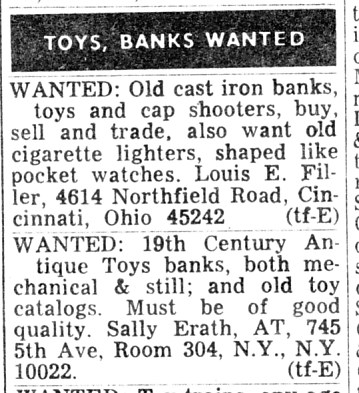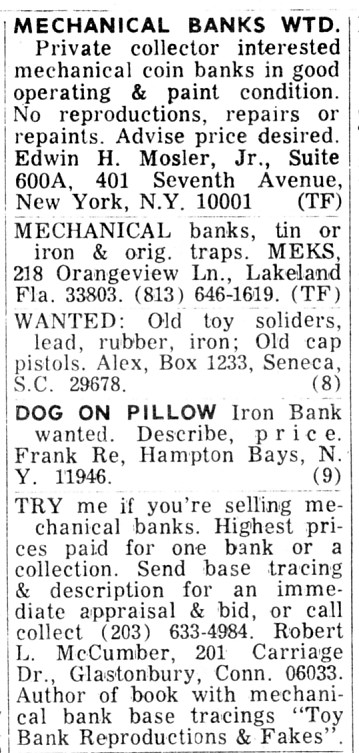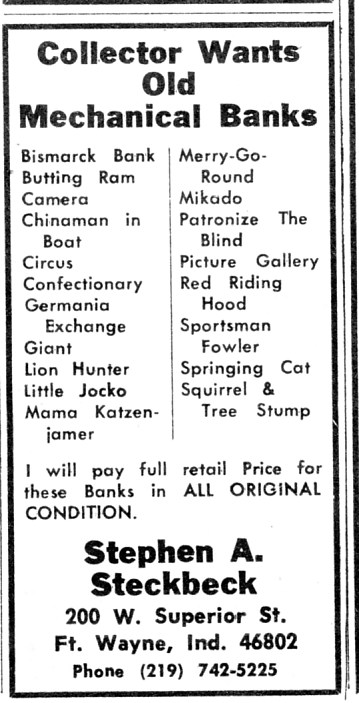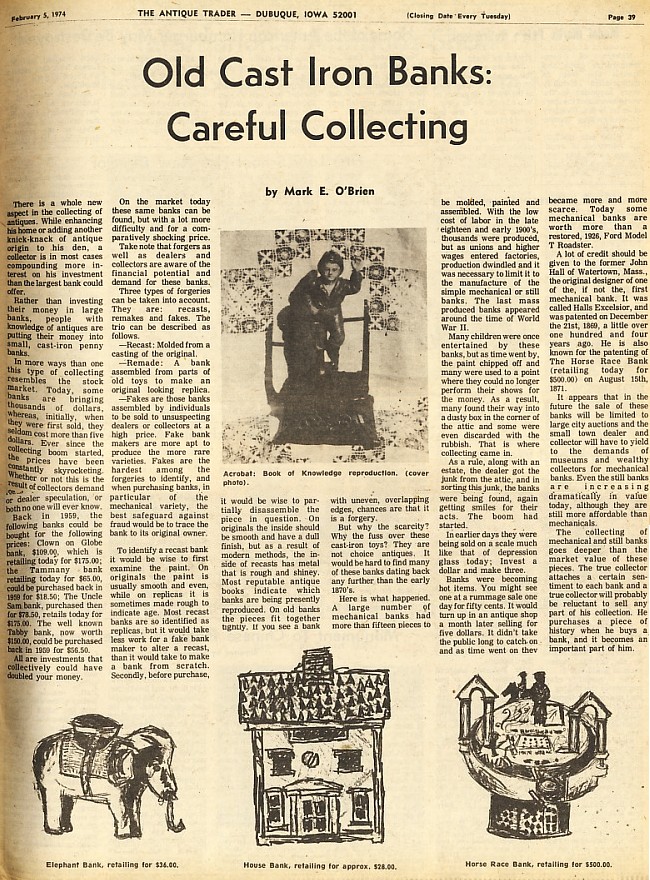|
THE ANTIQUE TRADER, Weekly,
Dubuque, Iowa, 52001 — February, 5, 1974
OLD CAST IRON BANKS: Careful Collecting
by Mark E. O'brion
There is a whole new aspect in the collecting of antiques. While
enhancing his home or adding another knick-knack of antique origin to
his den, a collector is in most cases compounding more interest on his
investment than the largest bank could offer.
Rather than investing their money in large banks, people with
knowledge of antiques are putting their money into small, cast-iron
penny banks.
In more ways than one this type of collecting resembles the stock
market. Today, some banks are bringing thousands of dollars, whereas,
initially, when they were first sold, they seldom cost more than five
dollars. Ever since the collecting boom started, the prices have been
constantly skyrocketing. Whether or not this is the result of collectors
demand or dealer speculation, or both no one will ever know.
Back in 1959, the following banks could be bought for the following
prices: Clown on Globe bank, $109.00, which is retailing today for
$175.00; the Tammany bank retailing today for $65.00, could be purchased
back in 1959 for $18.50; The Uncle Sam bank, purchased then for $78.50,
retails today for $175.00. The well known Tabby bank, now worth $150.00,
could be purchased back in 1959 for $56.50.
All are investments that collectively could have doubled your
money.
On the market today these same banks can be found, but with a lot
more difficulty and for a comparatively shocking price.
Take note that forgers as well as dealers and collectors are aware
of the financial potential and demand for these banks.
Three types of forgeries can be taken into account. They are:
recasts, remakes and fakes. The trio can be described as follows.
—Recast: Molded from a casting of the original.
—Remade: A bank assembled from parts of old toys to make an original
looking replica.
—Fakes are those banks assembled by individuals to be sold to
unsuspecting dealers or collectors at a high price. Fake bank makers are
more apt to produce the more rare varieties. Fakes are the hardest among
the forgeries to identify, and when purchasing banks, in particular of
the mechanical variety, the best safeguard against fraud would be to
trace the bank to its original owner.
To identify a recast bank it would be wise to first examine the
paint. On originals the paint is usually smooth and even, while on
replicas it is sometimes made rough to indicate age. Most recast banks
are so identified as replicas, but it would take less work for a fake
bank maker to alter a recast, than it would take to make a bank from
scratch. Secondly, before purchase, it would be wise to partially
disassemble the piece in question. On originals the inside should be
smooth and have a dull finish, but as a result of modern methods, the
inside of recasts has metal that is rough and shiney. Most reputable
antique books indicate which banks are being presently reproduced. On
old banks the pieces fit together tightly. if you see a bank with
uneven, overlapping edges, chances are that it is a forgery.
But why the scarcity? Why the fuss over these cast-iron toys? They
are not choice antiques. It would be hard to find many of these banks
dating back any further than the early 1870's.
Here is what happened. A large number of mechanical banks had more
than fifteen pieces to be molded, painted and assembled. With the low
cost of labor in the late eighteen and early 1900's, thousands were
produced, but as unions and higher wages entered factories, production
dwindled and it was necessary to limit it to the manufacture of the
simple mechanical or still banks. The last mass produced banks appeared
around the time of World War II.
Many children were once entertained by these banks, but as time
went by, the paint chipped off and many were used to a point where they
could no longer perform their shows for the money. As a result, many
found their way into a dusty box in the corner of the attic and some
were even discarded with the rubbish. That is where collecting came in.
As a rule, along with an estate, the dealer got the junk from the
attic, and in sorting this junk, the banks were being found, again
getting smiles for their acts. The boom had started.
In earlier days they were being sold on a scale much like that of
depression glass today; Invest a dollar and make three.
Banks were becoming hot items. You might see one at a rummage sale
one day for fifty cents. It would turn up in an antique shop a month
later selling for five dollars. It didn't take the public long to catch
on and as time went on they became more and more scarce. Today some
mechanical banks are worth more than a restored, 1926, Ford Model T
Roadster.
A lot of credit should be given to the former John Hall of
Watertown, Mass., the original designer of one of the, if not the, first
mechanical bank. It was called Halls Excelsior, and was patented on
December the 21st, 1869, a little over one hundred and four years ago.
He is also known for the patenting of The Horse Race Bank (retailing
today for $500.00) on August 15th, 1871.
It appears that in the future the sale of these banks will be
limited to large city auctions and the small town dealer and collector
will have to yield to the demands of museums and wealthy collectors for
mechanical banks. Even the still banks are increasing dramatically in
value today, although they are still more affordable than mechanicals.
The collecting of
mechanical and still banks goes deeper than the market value of these
pieces. The true collector attaches a certain sentiment to each bank and
a true collector will probably be reluctant to sell any part of his
collection. He purchases a piece of history when he buys a bank, and it
becomes an important part of him. |


 |



